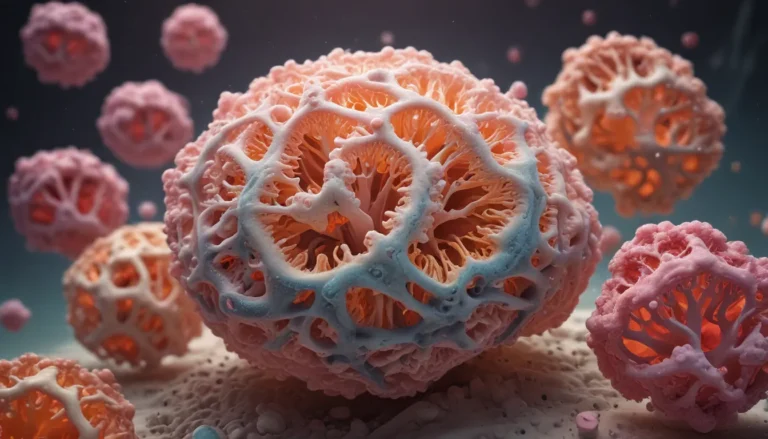A Note About Images: The images used in our articles are for illustration purposes only and may not exactly match the content. They are meant to engage readers, but the text should be relied upon for accurate information.
Are you intrigued by the hidden world of plant immune response? Plants are not merely passive beings; they have a sophisticated defense system in place to combat pathogens and pests. Join us as we unravel the fascinating realm of plant immunity and uncover 13 captivating facts about how plants defend themselves. From recognizing pathogens to communicating with each other, plants have evolved remarkable strategies to ensure their survival in challenging environments. Let’s embark on a journey to explore the incredible world of plant immune response together!
Unveiling the Plant Immune System
Plants possess an innate immune system that assists them in defending against various pathogens and pests. Unlike humans and animals, plants have developed their own unique strategies to fend off diseases, making their immune response a captivating subject of study.
The Power of Recognition and Response
Through the process of pattern recognition, plants can detect specific molecules produced by pathogens and activate their immune responses. This ability allows plants to swiftly respond to microbial signals, ensuring their survival in dynamic environments.
The First Line of Defense: Physical Barriers
Plants utilize physical barriers like bark, thorns, and waxy cuticles as the first line of defense against pathogens. These structures not only protect plants from external threats but also play a crucial role in maintaining their overall health.
- Bark, thorns, and waxy cuticles act as physical barriers against pathogens.
- These structures safeguard plants from external threats and contribute to their overall well-being.
Harnessing the Power of Antimicrobial Compounds
When plants detect pathogens, they produce antimicrobial compounds such as phytoalexins to inhibit the growth of invading organisms. This defense mechanism is a critical aspect of the plant immune response, allowing plants to combat pathogens effectively.
The Art of Communication: Chemical Signaling
Plants can communicate with each other through chemical signaling to enhance their immune response. By warning neighboring plants about potential threats, they can trigger immune responses in nearby plants, fostering a collective defense mechanism.
- Chemical signaling enables plants to warn neighboring plants and trigger immune responses.
- This communication system contributes to the overall defense strategy of plants.
Immune Memory: A Plant’s Adaptive Advantage
Plants have the remarkable ability to develop immune memory upon exposure to a particular pathogen. This immunological memory allows plants to mount a more effective response to future infections, showcasing their adaptability in challenging environments.
Tailored Defenses: Adapting to Pathogen Types
Plants can adjust their immune response based on the type of pathogen they encounter. By activating specific defense mechanisms tailored to bacteria, fungi, or viruses, plants showcase their versatility in combating diverse threats.
Balancing Act: The Role of Plant Hormones
Plant hormones such as salicylic acid and jasmonic acid play a crucial role in regulating immune responses. These hormones control the activation of plant immune systems and coordinate defense mechanisms, ensuring a harmonious response to pathogens.
Harnessing Symbiotic Relationships for Enhanced Immunity
Certain plants have evolved symbiotic relationships with beneficial microbes to enhance their immune system. These associations with beneficial bacteria and fungi can boost plant immune responses, providing an additional layer of protection against pathogens.
- Symbiotic relationships with beneficial microbes enhance plant immune responses.
- These associations contribute to the overall resilience of plants in challenging environments.
Unveiling the Receptors: Pattern Recognition in Plants
Plants have receptors on their cell surfaces called pattern recognition receptors (PRRs) that bind to pathogen molecules. By recognizing specific pathogen-associated molecular patterns (PAMPs), these receptors trigger immune responses, fortifying the plant’s defense mechanisms.
Genetic Variability: Influencing Immune Responses
Genetic variation within plant populations can impact the effectiveness of their immune responses. Some plants may exhibit variations in their immune system’s efficiency, making them more resistant to certain pathogens than others.
Environmental Influences on Plant Immune Responses
Climate conditions such as temperature and humidity can influence the expression of plant defense genes and affect their immune responses. These environmental factors play a pivotal role in shaping plant responses to pathogens and pests.
Plant Immunity and Agriculture: A Sustainable Approach
Understanding plant immune responses is crucial for developing sustainable crop protection strategies. By studying plant immune systems, researchers can explore eco-friendly methods to protect crops from diseases, reducing the dependence on chemical pesticides and promoting a healthier environment.
Conclusion: A World of Intrigue and Discovery
In conclusion, the realm of plant immune response offers a captivating journey into the intricate mechanisms that govern plant defense. Plants have developed sophisticated strategies to detect and fend off pathogens, showcasing their resilience in challenging environments. Delving into plant immunity not only provides insights into plant biology but also paves the way for practical applications in agriculture and crop protection.
Researchers continue to unravel the mysteries of plant immune response, shedding light on new genes, pathways, and signaling molecules involved in this essential process. By exploring plant immunity, we can unlock strategies to enhance crop resistance, reduce chemical pesticide usage, and improve agricultural productivity for a sustainable future.
FAQs
-
How do plants detect pathogens?
Plants utilize specialized receptors on their cell surfaces to recognize molecular patterns associated with pathogens. These receptors, known as pattern recognition receptors (PRRs), can detect components of microbial cell walls, flagella, or secreted proteins. Upon pathogen detection, a signaling cascade is triggered, activating the plant’s immune response. -
What are some examples of plant defense mechanisms?
Plant defense mechanisms include producing antimicrobial compounds, strengthening cell walls, initiating programmed cell death, and communicating with neighboring cells. These strategies enable plants to fend off pathogens effectively and maintain their health. -
Can plants remember past infections?
Recent studies suggest that plants have a form of immune memory known as priming. Following an initial pathogen attack, plants can develop an enhanced immune response upon subsequent infections by the same pathogen. This memory mechanism allows plants to mount a quicker and stronger defense, providing long-term protection. -
Are there natural plant immune boosters?
Compounds like salicylic acid and jasmonic acid found in plants can act as immune boosters, stimulating the plant’s defense mechanisms. Additionally, certain beneficial microbes, such as plant growth-promoting rhizobacteria, can enhance plant immunity and contribute to overall plant health. -
Can plants develop resistance to pathogens?
Plants possess the ability to develop resistance to pathogens through genetic mutations or acquiring resistance genes from other plant varieties or species. Breeding programs often capitalize on identifying and incorporating these resistance genes to cultivate disease-resistant crop varieties.
In a world filled with intriguing discoveries, the study of plant immune response stands as a beacon of knowledge, offering insights into nature’s ingenious defense mechanisms. As we unravel the complexities of plant immunity, we pave the way for sustainable agricultural practices and a greener future. Join us on this enchanting journey of exploration and discovery, where each fact uncovers a new layer of understanding in the captivating world of plant immune response.






